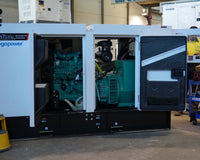Both Automatic Transfer Switches (ATS) and Load Banks are crucial components of diesel generators. We explore the basics of each components, their applications, and things to look out for when purchasing an ATS or a Load Bank.
Automatic Transfer Switch
To understand the basics and capability of an Automatic Transfer Switch, there are 3 common question that consumers would need to ask:
What is an Automatic Transfer Switch?
An automatic transfer switch (ATS) is a device that acts as an intermediary between the primary source to a backup source. The ATS will trigger when it senses a mains power failure or an outage and will send a signal to the backup source to start.
What application do you need to use an Automatic Transfer Switch?
An automatic transfer switch is generally used for a backup power system that usually coupled with a diesel generator. They are commonly used in data centre for an uninterrupted power systems setup, residential backup power, backup power during disasters and many more.
ATS are extremely useful for situations where there is a primary power source used in conjunction with a secondary power source. The ATS is what mediates the relationship between the two to ensure there is never any issues with power outages and blackouts.
How do you determine the right size of Automatic Transfer Switch for your diesel generator?
In order to determine the right size of automatic transfer switch, you would require an ampere (A) measurement from your respective diesel generator.
Take for example with a Gogopower diesel generator; you have purchased a 45kVA 3 phase diesel generator, DP15K5S-AU.
With DP45C5S-AU, it has an ampere output of 59.2A. This information can be found in Gogopower specification sheet or in the description. To match with an automatic transfer switch with this specific diesel generator that has an output of a 59.2A, a Gogopower AP63A, 63A 3 phase ATS would be the best fit as 59.2A is within the ATS capacity.
However if you have any other questions, feel free to enquire with our friendly customer service team.
Load Bank
What is a Load Bank?
A load bank is a device that produces an electrical load, it applies load to an electrical power source and this example the electrical power source would be a diesel generator and would converts the resultant power output of the source.
What application do you need to use a Load Bank?
Load bank can be used in various ways; permanent installed to a power source to ensure the diesel generator is operating at an optimum load capacity and not under glaze the engine.
Another way would be as testing mechanism to ensure the diesel generator are able to perform at different level of loads for safety and performance measurement.
We would categorize these two applications as:
- Resistive load bank
- Inductive load bank
Load banks are a crucial component to a diesel genset. A good genset will ensure the longevity of your diesel generator as well as minimise wear and tear. Diesel generators with better load banks will be more expensive, but their value for money is unparalleled.
How do you determine the right size of Load Bank
The simplest mistake anyone could make would be sizing a load bank too small or too big for your application. The best way to size the right size of load bank would be to understand the application of the diesel generator.
As mentioned there will be two common application of the load bank:
- Resistive load bank
- Inductive load bank.
With the resistive load bank, you would first need to take in certain factor such as starting load and ongoing load.
Take for example, a welding machine which requires 36A to start and will maintain a load of 18A of ongoing load with a Gogopower’s 45kVA 3 phase diesel generator, DP45C5S-AU. With that said, the ongoing load would 30% of load capacity which is harmful for the diesel generator which will cause the engine of the diesel generator to under glaze.
In which you would require a load bank to add load onto the diesel generator and this way the diesel generator would be able to perform at an optimal capacity at 60% - 80% load capacity.
To ensure the DP45C5S-AU with a total ampere output of 59.2A to perform at optimal condition, its best to go with a load bank that are able to assist the generator when the load is really low on the diesel generator at about 100kVA. This way you are future-proofing yourself for more bigger equipment which might have this same problem.
Conclusion
If you are still unsure what you would require for your application, it is understandable as each situation will require specific setup that will differ with the rest. If you enquire with our friendly customer service team, they will definitely help you out to help you determine which load bank is right for you!



